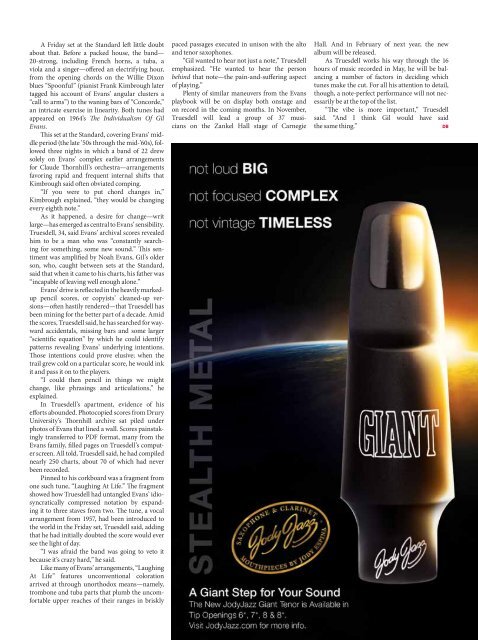Create successful ePaper yourself
Turn your PDF publications into a flip-book with our unique Google optimized e-Paper software.
A Friday set at the Standard left little doubt<br />
about that. Before a packed house, the band—<br />
20-strong, including French horns, a tuba, a<br />
viola and a singer—offered an electrifying hour,<br />
from the opening chords on the Willie Dixon<br />
blues “Spoonful” (pianist Frank Kimbrough later<br />
tagged his account of Evans’ angular clusters a<br />
“call to arms”) to the waning bars of “Concorde,”<br />
an intricate exercise in linearity. Both tunes had<br />
appeared on 1964’s The Individualism Of Gil<br />
Evans.<br />
This set at the Standard, covering Evans’ middle<br />
period (the late ’50s through the mid-’60s), followed<br />
three nights in which a band of 22 drew<br />
solely on Evans’ complex earlier arrangements<br />
for Claude Thornhill’s orchestra—arrangements<br />
favoring rapid and frequent internal shifts that<br />
Kimbrough said often obviated comping.<br />
“If you were to put chord changes in,”<br />
Kimbrough explained, “they would be changing<br />
every eighth note.”<br />
As it happened, a desire for change—writ<br />
large—has emerged as central to Evans’ sensibility.<br />
Truesdell, 34, said Evans’ archival scores revealed<br />
him to be a man who was “constantly searching<br />
for something, some new sound.” This sentiment<br />
was amplified by Noah Evans, Gil’s older<br />
son, who, caught between sets at the Standard,<br />
said that when it came to his charts, his father was<br />
“incapable of leaving well enough alone.”<br />
Evans’ drive is reflected in the heavily markedup<br />
pencil scores, or copyists’ cleaned-up versions—often<br />
hastily rendered—that Truesdell has<br />
been mining for the better part of a decade. Amid<br />
the scores, Truesdell said, he has searched for wayward<br />
accidentals, missing bars and some larger<br />
“scientific equation” by which he could identify<br />
patterns revealing Evans’ underlying intentions.<br />
Those intentions could prove elusive; when the<br />
trail grew cold on a particular score, he would ink<br />
it and pass it on to the players.<br />
“I could then pencil in things we might<br />
change, like phrasings and articulations,” he<br />
explained.<br />
In Truesdell’s apartment, evidence of his<br />
efforts abounded. Photocopied scores from Drury<br />
University’s Thornhill archive sat piled under<br />
photos of Evans that lined a wall. Scores painstakingly<br />
transferred to PDF format, many from the<br />
Evans family, filled pages on Truesdell’s computer<br />
screen. All told, Truesdell said, he had compiled<br />
nearly 250 charts, about 70 of which had never<br />
been recorded.<br />
Pinned to his corkboard was a fragment from<br />
one such tune, “Laughing At Life.” The fragment<br />
showed how Truesdell had untangled Evans’ idiosyncratically<br />
compressed notation by expanding<br />
it to three staves from two. The tune, a vocal<br />
arrangement from 1957, had been introduced to<br />
the world in the Friday set, Truesdell said, adding<br />
that he had initially doubted the score would ever<br />
see the light of day.<br />
“I was afraid the band was going to veto it<br />
because it’s crazy hard,” he said.<br />
Like many of Evans’ arrangements, “Laughing<br />
At Life” features unconventional coloration<br />
arrived at through unorthodox means—namely,<br />
trombone and tuba parts that plumb the uncomfortable<br />
upper reaches of their ranges in briskly<br />
paced passages executed in unison with the alto<br />
and tenor saxophones.<br />
“Gil wanted to hear not just a note,” Truesdell<br />
emphasized. “He wanted to hear the person<br />
behind that note—the pain-and-suffering aspect<br />
of playing.”<br />
Plenty of similar maneuvers from the Evans<br />
playbook will be on display both onstage and<br />
on record in the coming months. In November,<br />
Truesdell will lead a group of 37 musicians<br />
on the Zankel Hall stage of Carnegie<br />
Hall. And in February of next year, the new<br />
album will be released.<br />
As Truesdell works his way through the 16<br />
hours of music recorded in May, he will be balancing<br />
a number of factors in deciding which<br />
tunes make the cut. For all his attention to detail,<br />
though, a note-perfect performance will not necessarily<br />
be at the top of the list.<br />
“The vibe is more important,” Truesdell<br />
said. “And I think Gil would have said<br />
the same thing.”<br />
DB


